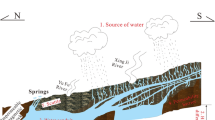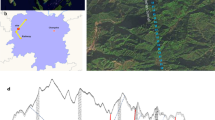Abstract
Electromagnetic wave CT technology, serving as an emerging geophysical method, is an effective way in detecting underground karst caves. In this paper, a numerical model for electromagnetic wave CT detection was established using Finite Difference Time Domain algorithm to interpret the propagation mechanism of electromagnetic wave in karst cave detection. The saturated sands with high porosity are adopted as the filling medium of the cave while the limestone is selected as the surrounding rock in this simulation. Propagation rules obtained from numerical simulation are drawn as follows: (1) when electromagnetic wave propagates inside the karst cave, refraction, reflection, diffraction, and obstacle gain behavior will occur. (2) The refraction phenomenon has relatively more influence on the energy absorption of electromagnetic wave while the disturbance of the waveform is principally attributed to the reflection phenomenon. (3) The influence of the factors such as the type of filling material and water content should be taken into account if the absorption coefficient of karst caves to electromagnetic wave is inconsistent. Furthermore, the tomographic images gained from experiment are interpreted according to the simulation conclusions. It is found that the analysis of tomographic images show general agreement with the previous exploration results, so it is feasible to use electromagnetic wave CT technology in karst cave exploration. The research presented herein aimed to serve as a based theory for analyzing tomography results in the field of karst caves exploration.
Graphic abstract
















Similar content being viewed by others
References
Abdallatif T, Khafagy ASAB, Khozym A (2015) Geophysical investigation to delineate hazardous cavities in Al-Hassa Karstic Region, Kingdom of Saudi Arabia. Eng Geol Soc Territ. https://doi.org/10.1007/978-3-319-09048-1_98
Al-Fares W, Bakalowicz M, Guerin R, Dukhan M (2002) Analysis of the karst aquifer structure of the lamalou area (Herault, France) with ground penetrating radar. J Appl Geophys 51(2):97–106. https://doi.org/10.1016/S0926-9851(02)00215-X
Bai HR, Li JJ (2013) Evaluation of grouting effect detection in goaf. Appl Mech Mater 438–439:1080–1083. https://doi.org/10.4028/www.scientific.net/AMM.438-439.1080
Carriere SD, Chalikakis K, Sénéchal G, Danquigny C, Emblanch C (2013) Combining electrical resistivity tomography and ground penetrating radar to study geological structuring of karst unsaturated zone. J Appl Geophys 94(4):31–41. https://doi.org/10.1016/j.jappgeo.2013.03.014
Chamberlain AT, Sellers W, Proctor C et al (2000) Cave detection in limestone using ground penetrating radar. J Archaeol Sci 27(10):957–964. https://doi.org/10.1006/jasc.1999.0525
Counts T, Larson G, Gürbüz AC, Mcclellan JH, Scott Jr WR (2007) Investigation of the detection of shallow tunnels using electromagnetic and seismic waves. In: Proceedings of the SPIE, vol 6553, pp 65531G–65531G-11. https://doi.org/10.1117/12.722437.
Eringen AC (2006) Micromorphic electromagnetic theory and waves. Found Phys 36(6):902–919. https://doi.org/10.1007/s10701-006-9044-1
Gedney D (1996) An anisotropic perfectly matched layer-absorbing medium for the truncation of FDTD lattices. IEEE Trans Antennas Propag 44(12):1630–1639. https://doi.org/10.1109/8.546249
Hiltunen DR, Cho GC (2005) Synthetic crosshole tomography studies of bridge foundation sites in Karst Terrane. In: Symposium on the application of geophysics to engineering and environmental problems. Environment and Engineering Geophysical Society. https://doi.org/10.4133/1.2923451
Kašpar M, Pecen J (2010) Detection of caves in a karst formation by means of electromagnetic waves. Geophys Prospect 23(4):611–621. https://doi.org/10.1111/j.1365-2478.1975.tb01548.x
Kesar AS (2011) Underground anomaly detection by electromagnetic shock waves. IEEE Trans Antennas Propag 59(1):149–153. https://doi.org/10.1109/TAP.2010.2090486
Kyun PS (2008) Detecting defects in or behind tunnel lining concrete using electromagnetic wave radar with change of antenna type and frequency domain. Mod Phys Lett B 22(11):989–994. https://doi.org/10.1142/S0217984908015723
Martínez-Moreno FJ, Galindo-Zaldívar J, Pedrera A, Teixido T, Ruano P et al (2014) Integrated geophysical methods for studying the karst system of Gruta de las maravillas (Aracena, Southwest Spain). J Appl Geophys 107:149–162. https://doi.org/10.1016/j.jappgeo.2014.05.021
Mochales T, Casas AM, Pueyo EL et al (2008) Detection of underground cavities by combining gravity, magnetic and ground penetrating radar surveys: a case study from the Zaragoza area, NE Spain. Environ Geol 53(5):1067–1077. https://doi.org/10.1007/s00254-007-0733-7
Neal A (2004) Ground-penetrating radar and its use in sedimentology: principles, problems and progress. Earth Sci Rev 66(3):261–330. https://doi.org/10.1016/j.earscirev.2004.01.004
Smirnov Y, Tsupak AA (2018) Investigation of electromagnetic wave diffraction from an inhomogeneous partially shielded solid. Appl Anal 97:1–15. https://doi.org/10.1080/00036811.2017.1343467
Taflove A, Hagness SC, Piket-May M (2005) Computational electromagnetics: the finite-difference time-domain method. Electr Eng Handb 5:629–670. https://doi.org/10.1002/9781118716410.ch14
Xiao H, Qin J, Ogai H, Jiang X (2015) A new standing-wave testing system for bridge structure nondestructive damage detection using electromagnetic wave. IEEJ Trans Electr Electron Eng 10(2):157–165. https://doi.org/10.1002/tee.22048
Acknowledgements
The authors gratefully acknowledge the finances support provided by National Science Foundation of China (Nos. 51678547 and 41807262), Natural Science Foundation of Hubei Province (No. 2018CFB179), China Postdoctoral Science Foundation (No. 2017T00664), Fundamental Research Funds for the Central Universities, China University of Geosciences (Wuhan) (No. CUG170647).
Funding
There has been no significant financial support for this work that could have influenced its outcome.
Author information
Authors and Affiliations
Contributions
SH designed the experiments and wrote the manuscript; JL performed the experiments and completed the numerical simulation. QH analyzed the data; RL revised the manuscript and contributed to methodology design.
Corresponding author
Ethics declarations
Conflict of interest
The authors wish to confirm that there are no known conflicts of interest associated with this publication.
Additional information
Publisher's Note
Springer Nature remains neutral with regard to jurisdictional claims in published maps and institutional affiliations.
Rights and permissions
About this article
Cite this article
Huang, S., Lin, J., Huang, Q. et al. An Emerging Method Using Electromagnetic Wave Computed Tomography for the Detection of Karst Caves. Geotech Geol Eng 38, 2713–2723 (2020). https://doi.org/10.1007/s10706-019-01180-w
Received:
Accepted:
Published:
Issue Date:
DOI: https://doi.org/10.1007/s10706-019-01180-w




